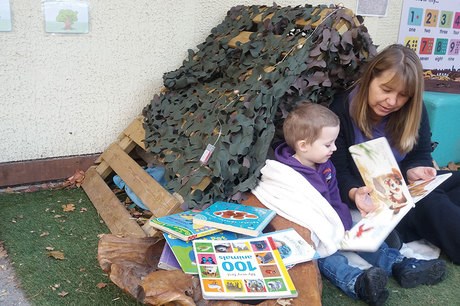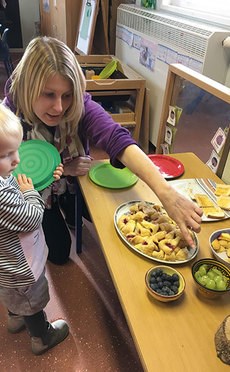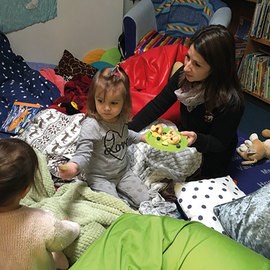Enabling Environments: Well-Being - Cosy up!
Alison Prowle and Angela Hodgkins
Monday, December 12, 2016
The Danish concept of ‘hygge’ can promote well-being, find Alison Prowle and Angela Hodgkins

We have long looked to our Nordic colleagues for inspiration regarding children’s outdoor learning, with Froebel-inspired Forest Schools now a valued aspect of our early years pedagogy. With myriad benefits to children including improved physical health, problem-solving, creativity, risk-taking and social development, it is no wonder that the EYFS places such a strong emphasis on learning in the outdoor environment. However, in winter, many of us experience the need to get cosy, especially after a period spent outdoors.
The Danish concept of hygge could have something to offer as we explore how to create warm and welcoming indoor and outdoor environments and practices that address children’s social and emotional needs.

Hygge (pronounced ‘hoogah’), first documented in 18th-century Denmark, lacks an exact English translation, although some have argued that it is etymologically related to the English word ‘hug’. Hygge can be a verb or a noun. It is generally translated as ‘cosiness’, but embodies more than that. Some have defined it as a ‘cosiness of the soul’.
Susanne Nilsson, a hygge teacher, describes hygge as ‘the absence of anything annoying or emotionally overwhelming; taking pleasure from the presence of gentle, soothing things.’ Denmark is, according to the World Happiness Survey, the happiest nation in the world (compared with the UK at 23rd) and some attribute this in part at least to hygge.
So, if the hygge approach encourages us to spend quality time together in a relaxed, warm atmosphere and brings with it cosiness, closeness and gentle contentment, how can we bring more hygge into our early years practice?
THE HYGGE ENVIRONMENT
Hygge embraces the indoor area and is associated with comfort, cosiness and pleasure. Therefore, a setting wishing to adopt hygge ideas should be as homely as possible, with ornaments, plants and pictures creating a ‘home from home’ and using natural materials. The environment must be warm, and lighting should not be too bright or harsh. Dimmed lighting, fairy lights and even candles can give a cosy effect (health and safety permitting!).
Settings may find it more manageable to create a ‘hygge corner’, an oasis of calm and cosiness that children can retreat to. Blankets, cushions, fleeces and faux fur throws can be used to make a warm snug area where children can relax. There should be no electronic devices present, just books and pictures to look at in peace. Texture and feel are very important, with many Danish settings having a dog or cat for children to stroke. Try making the area dim by using fabric suspended over the area, and string fairy lights around for a truly cosy and magical den.
Denmark has harsh winters with up to 17 hours of darkness, so the hygge concept is often associated with indoor areas, but it also relates to outdoor spaces. Forest Schools originated in Denmark, and getting outside in all weather is important in hygge – as long as there is a warm, cosy corner waiting for when you return.
Group learning and togetherness are key, so creating dens for children and materials for them to make their own dens is very ‘hygge’. Learning about nature together is valuable, so gardening, composting, growing food and looking after the birds by building bird houses and feeding birds are lovely activities for children to be involved in.
Make sure that your setting has enough hats and gloves to keep all children cosy and warm when they are outside. In summer, picnics outside can be very hygge, sharing food and conversation. You could also have picnics outside on a bright, cold autumn day, with everyone wrapped up warmly and blankets provided, eating warm food.

HYGGE EATING
The hygge concept of food is that it should be a pleasurable experience, with no-one feeling deprived of anything they like to eat. This is particularly important for children who may have particular dietary needs. Providing food that everyone can share enables all children to feel included. However, it is also about eating ‘mindfully’; enjoying the food and spending time enjoying eating with others. In hygge, healthy eating is important, but so is pleasure.
In an early years setting, allow as long as possible for meal times; use tablecloths and beautiful crockery. Eat together, children and adults, and make it a relaxed, social experience. Keep things simple and make your own food whenever you can, baking with the children or cooking the vegetables and fruit grown in your own garden. Sharing is good, and also offers a learning experience, so try providing small bowls of food for children to share, tapas-style. Children who eat mindfully will naturally limit their own eating to the amount that they need.
COLLECTIVE SINGING, STORY AND FOLKLORE
Denmark enjoys a rich folklore tradition, made up of stories, fairy tales, legends, singing and dancing. Jessica Alexander, one of the authors of The Danish Way of Parenting, describes these activities as demonstrating the importance of ‘we’ time, as opposed to ‘me’ time. Any activity that brings children together with a sense of community and common purpose could contribute towards hygge.
Singing together can be hugely enjoyable for children and adults, and research suggests it benefits both physical and emotional health and well-being, from strengthening core muscles to releasing feelgood endorphins. There are cognitive benefits too, ranging from developing speech and language skills to enabling creativity, imagination and memory.
As the home nation of Hans Christian Andersen, it is no surprise that storytelling plays such an important role in Danish early years pedagogy. Young children can benefit from listening to and sharing stories. Stories can help develop a sense of wonder at the world. They can teach important truths about ourselves, others and the world we live in.
By exposing children to varied stories, they can explore the folklore of their own culture as well as entering imaginatively into the worlds of others. This helps to develop respect for different religions, nationalities and cultures. Stories taught in a multi-sensory manner (with actions, puppets and interactions) can help bring the stories alive and make them memorable. Creating cosy, welcoming spaces for story and song-time can add to the enjoyment, sense of security and hygge.
HYGGE AT HOME
Some people have argued that with its family-friendly policies such as flexible working patterns, generous shared parental leave and affordable childcare, Denmark is one of the best places to bring up children. Perhaps hygge plays a role in this too?
Denmark prides itself on having a healthy work-life balance, with family time prioritised and valued. With both parents working, children are encouraged to be independent and to take responsibility. Eating and playing together are highly valued, and getting out into the natural environment on walks or bicycle rides is an important part of family life.
It may be possible to involve families in your project by sending home hygge ideas sheets and encouraging families to enjoy cosy experiences.
CASE STUDY: BUSY BEES NURSERY, LEDBURY

Emma Davies and the staff at Busy Bees Nursery, Ledbury, Worcestershire, have embraced the hygge concept and have created numerous opportunities for cosy moments within the setting. The reading corner has been transformed with fairy lights, cushions and throws, and existing outdoor structures have been given their own hygge makeover.
Ms Davies says, ‘We’ve all enjoyed thinking about the meaning of hygge and how we already provide ways to embrace this concept, as well as what else we could do to offer more opportunities. The children have been so relaxed and calm since adopting this approach. We’ll now be offering them the resources so they can create their own cosy spaces in addition to the spaces created by us. We already have a shopping list of more blankets, cushions, lights and natural resources!’
Alison Prowle and Angela Hodgkins are senior lecturers at the Centre for Children and Families, University of Worcester
MORE INFORMATION
- ‘Hygge: A heart-warming lesson from Denmark’, www.bbc.co.uk/news/magazine-34345791
- www.visitdenmark.co.uk/en-gb/denmark/culture/art-danish-hygge
- ‘The hygge conspiracy’, www.theguardian.com/lifeandstyle/2016/nov/22/hygge-conspiracy-denmark-cosiness-trend
Download thePDF





